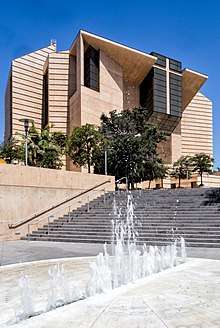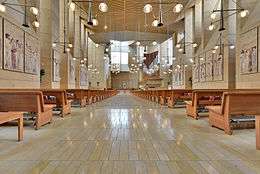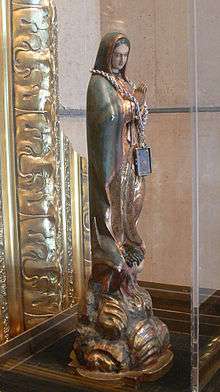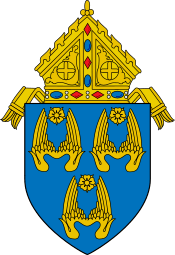Cathedral of Our Lady of the Angels (Los Angeles)
| Cathedral of Our Lady of the Angels | |
|---|---|
 | |
| 34°3′30″N 118°14′45″W / 34.05833°N 118.24583°WCoordinates: 34°3′30″N 118°14′45″W / 34.05833°N 118.24583°W | |
| Location |
555 W. Temple St. Los Angeles, California |
| Country | United States |
| Denomination | Roman Catholic |
| Website | www.olacathedral.org |
| History | |
| Founded | 2002 |
| Architecture | |
| Architect(s) | Rafael Moneo |
| Style | Modern architecture; deconstructivist elements |
| Completed | 2002 |
| Construction cost | $250 million |
| Specifications | |
| Capacity | 3,000 people |
| Length | 333 feet (101 m) ; nave |
| Administration | |
| Archdiocese | Los Angeles |
| Clergy | |
| Archbishop | Most Rev. José Horacio Gómez |
| Pastor(s) | Fr. David Gallardo |
The Cathedral of Our Lady of the Angels, informally known as COLA or the Los Angeles Cathedral, is a cathedral of the Roman Catholic Church in Los Angeles, California, United States of America. Opened in 2002, it serves as the mother church for the Archdiocese of Los Angeles,[1] as well as the seat of Archbishop José Horacio Gómez.[2]
The structure replaced the Cathedral of Saint Vibiana, which was severely damaged in the 1994 Northridge earthquake. Under Cardinal Roger Mahony, Our Lady of the Angels was begun in 1998 and formally opened in September 2002. There was considerable controversy over both its deconstructivist and modern design and exceptional costs incurred in its construction and furnishing, as well as the archdiocese's decision to build a crypt under the Cathedral.[3]
The Cathedral is named in honor of the Blessed Virgin Mary under the patronal title of Our Lady of the Angels, echoing the full name of the original settlement of Los Angeles (Spanish: El Pueblo de Nuestra Señora la Reina de los Ángeles, or "The Town of Our Lady the Queen of the Angels").[4] The Cathedral is widely known for enshrining the relics of Saint Vibiana and tilma piece of Our Lady of Guadalupe. It is the mother church to approximately five million professed Catholics in the archdiocese.[5]
Design
The Cathedral was designed by the Pritzker Prize-winning Spanish architect Rafael Moneo.[1][6] Using elements of postmodern architecture, the church and the Cathedral Center feature a series of acute and obtuse angles while avoiding right angles. Contemporary statuary and appointments decorate the complex. Prominent of these appointments are the bronze doors and the statue called The Virgin Mary, all adorning the entrance and designed by Robert Graham.
In addition to the church, the cathedral grounds also include a mausoleum, gift shop, cafeteria, conference center, and clergy residences. The relics of Saint Vibiana are interred in the mausoleum, as are the remains of several past bishops, archbishops, and auxiliary bishops of Los Angeles. The size of the cathedral is 6,038 square meters (65,000 square feet).
History

The Cathedral of Saint Vibiana had served as the cathedral of the Los Angeles see since its completion in 1876. Soon after its completion, the diocese noted it to be of inferior construction quality and also too small for Los Angeles' rapidly growing population. In 1904, Bishop Thomas James Conaty gained permission from the Holy See to build a new cathedral to be named after Our Lady of Guadalupe and purchased a site on which to build the cathedral. However, an economic downturn in 1907 put a stop to the project; a Catholic parish church was later built on the site. In the 1940s, plans were drawn up for a new cathedral on Wilshire Boulevard that would seat 3,000 people, and in 1945 Archbishop John Joseph Cantwell announced that the Holy See approved the name "Cathedral of Our Lady of the Angels". That cathedral was never built, however, as Cantwell died in 1947 and his successor, James Francis McIntyre, decided that building churches and schools was a more pressing need for the archdiocese. McIntyre gained permission from donors to redirect money donated to Cantwell's cathedral fund to fund construction of churches and schools.

The 1994 Northridge earthquake severely damaged the Cathedral of Saint Vibiana, which led the archdiocese to close the cathedral due to safety concerns. In January 1995 the archdiocese announced plans to build a new cathedral on the Saint Vibiana site, plans which necessitated the demolition of the old cathedral. This led to a lengthy legal battle between the archdiocese and preservationists, who argued that the cathedral was a city landmark and that it should be either incorporated into the new cathedral or otherwise saved. The archdiocese contended that restoring the old cathedral would cost $18–20 million, an amount that it contended no one would donate.[7]
This legal battle prompted the archdiocese to look to build the cathedral on a new site. In December 1996, the archdiocese announced it was purchasing a 5.6-acre (2.3 ha) site between Temple Street and the Hollywood Freeway from Los Angeles County at a cost of $10.85 million.[7] The archdiocese chose to retain the "Cathedral of Our Lady of the Angels" name approved by the Vatican in the 1940s. The initially proposed budget for the project was $150 million, rising to a final cost of $189.7 million. The construction was supervised by Father Richard S. Vosko, a liturgical design consultant and priest of the Diocese of Albany who has overseen the design and renovation of numerous churches and cathedrals in the United States.[8] Construction began in 1998 and was completed in September 2002. Meanwhile, the old cathedral was eventually restored by developers Tom Gilmore and Richard Weintraub, who spent around $6 million converting it into an events center and performance venue.
Criticism

Cardinal Roger Mahony's decision to build a new Los Angeles Cathedral in such elaborate and modern architecture has drawn great criticism. Many argued that a church of that size and expense was unnecessary, overly-elaborate and the money could have been better spent on social programs.[9] Many felt that either St. Vincent Church on West Adams Boulevard or St. Basil Church on South Kingsley Drive could easily perform the functions required of a cathedral with minimal additional cost. Our Lady of the Angels Cathedral was also criticized for its departure from historical California Mission-style architecture and aesthetics. Many also criticised the structure for being a "failed architecture" as it did not convey Christianity through its lack of iconography, and iconography that was aimed at being 'inclusive' instead of Catholic.[10] Certain critics to dubbed it the "Taj Mahony"[11] and the "Rog Mahal".[12]
Organ
The organ is opus 75 of Dobson Pipe Organ Builders of Lake City, Iowa and is a 105 rank/ 4 manual instrument that incorporates pipes from the 1929 Wangerin organ of St. Vibiana's Cathedral. Dobson's Opus 75 has a total of 6,019 pipes. It is the 89th largest pipe organ in North America and the 143rd largest in the world.[13] The St. Vibiana instrument was rebuilt in 1988 by Austin Organs[14] The organ case is approximately 60 feet (18 m) high, and is located approximately 24 feet (7.3 m) above the floor. To meet earthquake-stability requirements, the pipes and case are supported by a massive internal steel frame.[14]
Mausoleum

The cathedral features a mausoleum in its lower level, containing 1,270 crypts and 4,746 columbarium niches for burials. Proceeds from the sale of memorials and burial spaces are placed in an endowment fund to support the cathedral.[15]
All past ordinaries of the archdiocese are memorialized in the mausoleum, including a future burial site for Cardinal Roger Mahony, and the remains of several ordinaries and auxiliary bishops who died before the cathedral was built were transferred there.[16] The tomb of Saint Vibiana was transferred to the cathedral from its previous location above the altar at the Cathedral of Saint Vibiana; the tomb is the centerpiece of the St. Vibiana Chapel located adjacent to the mausoleum.
The crypt mausoleum features a number of stained glass windows that were originally installed in Saint Vibiana's Cathedral. This idea was suggested by Mario Agustin Locsin, a renowned Liturgical Artist and consultant on the renovation. The old cathedral windows were restored and two new windows featuring guardian angels created by The Judson Studios were placed at the entrance to the crypt mausoleum.[17]
List of people buried at the Cathedral
Clergy
- Bishop Juan Arzube
- Thaddeus Amat y Brusi, first Bishop of Los Angeles
- John Cantwell, first Archbishop of Los Angeles
- Bishop Thomas James Conaty
- Bishop Carl Anthony Fisher
- James Francis McIntyre, second Archbishop of Los Angeles, who was created Cardinal
- John J. Ward, auxiliary bishop
Laity
- Bernardine Murphy Donohue, philanthropist and papal countess
- Victor and Loretta Baron Mahony, parents of Cardinal Roger Mahony
- June Marlowe, actress
- Gregory Peck, actor[18]
- Saint Vibiana, patron saint of the Archdiocese of Los Angeles
Events
.jpg)
On September 3, 2011, the Cathedral played host to a Votive Mass in honour of the Blessed Virgin Mary. The Mass marked the conclusion of the First Annual Grand Marian Procession organised by the Queen of Angels Foundation.
Every Wednesday afternoon, the cathedral holds an organ recital. It is free and open to the public.[19]
See also
References
- 1 2 "About: History". Cathedral of Our Lady of the Angels. Retrieved July 18, 2011.
- ↑ "Archbishop José Horacio Gómez Velasco". Catholic-Hierarchy.org. David M. Cheney. Retrieved 21 January 2015.
- ↑ "Why Are There So Many Ugly Churches? - an interview with Morya Doorly". Ignatius Insight. August 13, 2007.
- ↑ The Franciscan friars who founded the pueblo town named it for Santa Maria degli Angeli (Italian for "St. Mary of the Angels"), the locality within Assisi where St. Francis began his movement on a "little portion of land" called the Porziuncola.
- ↑ "Welcome". Cathedral of Our Lady of the Angels. Retrieved January 16, 2008.
- ↑ "About: Architect". Cathedral of Our Lady of the Angels. Retrieved July 18, 2011.
- 1 2 "About: History". Cathedral of Our Lady of the Angels. Retrieved March 16, 2011.
- ↑ Richard S. Vosko: Cathedral of Our Lady of Angels Archived 2011-12-13 at the Wayback Machine. retrieved May 23, 2011
- ↑ "$2.5 Million Given for Fountain at New Cathedral". Los Angeles Times. LATimes.com. November 15, 2001. Retrieved July 18, 2011.
- ↑ Rose, Michael. Ugly as Sin.
- ↑ Haslam, Chris (February 24, 2008). "Art attack in LA". Sunday Times. London (UK). p. 4.
- ↑ Ordonez, Jennifer (April 10, 2006). "The Catholics: A Cardinal's Campaign; Cardinal Roger Mahony of Los Angeles is speaking out against crackdowns on illegals. How far will his voice carry?". Newsweek. 147 (16). p. 38.
- ↑ "About the Organ". http://www.olacathedral.org. Retrieved September 9, 2014. External link in
|website=(help) - 1 2 "Cathedral of Our Lady of Angles". DobsonOrgan.com. Retrieved July 18, 2011.
- ↑ "Mausoleum: About". Cathedral of Our Lady of the Angels. Retrieved July 18, 2011.
- ↑ Larry B. Stammer (16 March 2001). "The Lady Appears". Los Angeles Times. LATimes.com. Retrieved July 18, 2011.
- ↑ "Mausoleum: Stained Glass Windows". Cathedral of Our Lady of the Angels. Retrieved July 18, 2011.
- ↑ "Find A Grave: Gregory Peck". Retrieved September 21, 2006.
- ↑ "Organ Recital at the Cathedral". http://www.performingartslive.com. Retrieved September 9, 2014. External link in
|website=(help)
Further reading
- Bühren, Ralf van: Kunst und Kirche im 20. Jahrhundert. Die Rezeption des Zweiten Vatikanischen Konzils, Paderborn: Ferdinand Schöningh 2008, pp. 609–610, ill. 85-87 ( ISBN 978-3-506-76388-4)
External links
| Wikimedia Commons has media related to Cathedral of Our Lady of the Angels. |

_edit1.jpg)